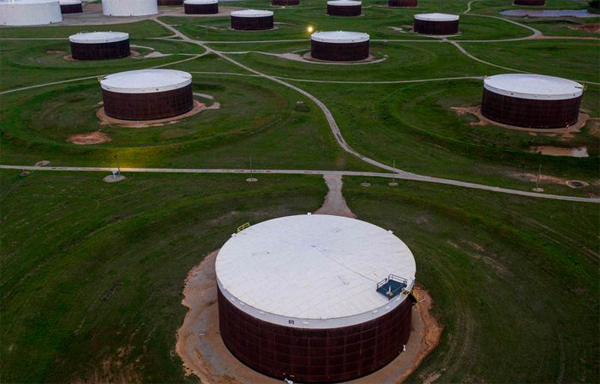Natural-gas futures score back-to-back session gains

Myra P. Saefong and William Watts, MarketWatch
SAN FRANCISCO/NEW YORK
EnergiesNet.com 02 23 2023
Oil futures settled higher on Thursday, with U.S. prices notching their first gain in seven sessions, as data showed a weekly decline in domestic gasoline supplies along with a nearly 8 million-barrel climb in crude inventories.
Price action
- West Texas Intermediate crude for April delivery CL.1, 0.41% CL00, 0.41% CLJ23, 0.41% rose $1.44, or nearly 2%, to settle at $75.39 a barrel on the New York Mercantile Exchange, trimming its weekly decline to 1.5% after it fell for a sixth straight session on Wednesday.
- April Brent crude BRNJ23, 0.45%, the global benchmark, rose $1.61, or 2%, to $82.21 a barrel on ICE Futures Europe. May
Brent BRN00, 0.38% BRNK23, 0.39%, the most actively traded contract, added $1.50, or 1.9%, at $81.95 a barrel. - Back on Nymex, March gasoline RBH23, -0.33% rose 1.8% to $2.3795 a gallon.
- March heating oil HOH23, 1.16% edged down by nearly 0.3% to $2.7081 a gallon.
- March natural gas NGH23, +1.77% added 6.4% to $2.314 per million British thermal units after a 4.9% rise Wednesday.
Supply data
The Energy Information Administration on Thursday reported that U.S. crude inventories rose by 7.6 million barrels for the week ended Feb. 17.
On average, analysts forecast a climb of 1 million barrels, according to a poll conducted by S&P Global Commodity Insights. The American Petroleum Institute, an industry trade group, late Wednesday said U.S. crude inventories jumped by 9.9 million barrels last week, according to a source citing the data.
The EIA data includes an upward “adjustment” to crude stocks of 2.073 million barrels per day for the week ended Feb. 17. That followed a 1.967 million-barrel upward adjustment the week before.
Read: What are these EIA ‘adjustments’ in the weekly U.S. oil supply data tables all about?
“With the adjustment factor holding this high, this suggests that the EIA is not only underestimating domestic crude production but also underestimating net imports of crude — and potentially overestimating refinery runs amid what was expected to be the largest period of seasonal maintenance in recent history,” Troy Vincent, senior market analyst at DTN, told MarketWatch.
The EIA report, which was released a day later than usual due to Monday’s Presidents Day holiday, also showed a weekly inventory decline of 1.9 million barrels for gasoline, while distillate supplies rose by 2.7 million barrels. The analyst survey had forecast inventory declines of 400,000 barrels for gasoline and 1.3 million barrels for distillates.
The gasoline inventories decline came on the back of a second consecutive drop in gasoline imports and a nearly 700,000 barrel per day weekly rise in gasoline product supplied, a proxy for demand, said Vincent. Gasoline demand has “clearly began its seasonally normal strengthening trend.”
Crude stocks at the Cushing, Okla., Nymex delivery hub rose by 700,000 barrels for the week, the EIA said.
Elsewhere in the energy market, U.S. natural-gas futures have dropped 14% in February and more than 48% so far in 2023, slumping in reaction to mild winter weather and strong domestic supplies.
Commodities Corner: Why the wait for lower heating bills may last for ‘months to come’
A sharp rise in natural-gas prices following Russia’s invasion of Ukraine, which took place a year ago Friday, had led some European power providers to burn oil, boosting demand for crude. Natural-gas prices subsequently tumbled.
Read: Why U.S. fuel prices continue to feel the effects of Russia’s invasion of Ukraine
The EIA released weekly data on natural-gas storage Thursday showing domestic natural-gas supplies fell by 71 billion cubic feet for the week ended Feb. 17. Analysts surveyed by S&P Global Commodity Insights, on average, were looking for a withdrawal of 72 bcf.
The five-year average drawdown for the period is 177 bcf, while supplies saw a decline of 138 bcf for the same week last year, according to S&P Global Commodity Insights.
Other market drivers
Crude has struggled in February as investors recalibrated expectations for Federal Reserve rate hikes. Fed action has stoked fears that the effort to bring down inflation could trigger a sharp economic slowdown that would weigh on demand for crude and fuel.
Minutes of the Fed’s Jan. 31-Feb. 1 policy meeting released Wednesday afternoon affirmed that policy makers were solidly behind plans to continue raising rates, but offered no major surprises.
Meanwhile, traders are keeping an eye on fuel demand.
Weekly product supplied for gasoline, a proxy for demand, jumped nearly 700,000 barrels per day, contributing to a fall in gasoline stockpiles last week.
Gasoline demand has “clearly began its seasonally normal strengthening trend,” said DTN’s Vincent, but the four-week average measure for gasoline product supplied continues to remain 119,000 bpd below year-ago levels.
Anniversary
The oil market has seen changes in the year since Russia’s invasion of Ukraine.
Read: The real impact of Russia’s invasion of Ukraine on commodities
“The war itself has not yet materially affected actual volumes of oil flows globally, but war, by its very nature, introduces massive uncertainty,” said Jim Burkhard, vice president and head of crude oil market and energy and mobility research at S&P Global Commodity Insights.
The Russia-Ukraine war was a great market driver in 2022, and will be in 2023 as well, but there are “additional drivers the market is focusing on for 2023: China’s reopening and dynamics of OPEC+ relations between Saudi Arabia and Russia,” said Burkhard, in emailed commentary. “Government intervention in the oil market, particularly by the U.S., could again have an impact as it did in 2022.”
Overall, “oil markets are now a reflection of divisions between Russia and the West and China and the West,” said Burkhard.
marketwatch.com 02 23 2023












